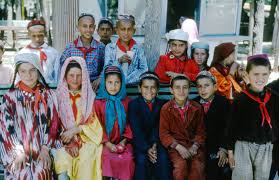The language policies of the Central Asian republics since their independence have needed to respond to linguistic complexities that emerged during the period of colonisation by Russia. These issues include the development of local languages as languages of administration and education, the ethnolinguistic profile of the region, the impact of the Russian language on local language ecologies, and the impact of English as a language of globalisation.
At the time of their colonisation by Russia in the eighteenth and nineteenth centuries, Central Asia was predominantly Muslim in religion and linguistically Turkic, with the exception of Persian-speaking Tajikistan. These languages were written in the Arabic script, where they were written at all, and education was provided by Islamic schools, which taught Arabic, mainly for the purposes for Qu’ranic recitation. Following the Russian annexation, apart from immigration of Russian speakers into the region, there was limited intervention into the local language ecologies until 1864 when the Tsarist government enacted an education statute requiring all teaching to be conducted in Russian. However, access to such education was limited andliteracy rates in Russian were around 1% by the time of the 1917 Revolution.

Following the Revolution, the Communist government eventually established five republics in Central Asia based a policy of establishing national ethnolinguistic groups. Although each republic was assigned to a titular nationality, this masked a much more complex distribution of ethnic groups in the region. While the titular nationality was the majority in each republic, there were sizable minorities of other ethnic groups in each republic. Moreover, each titular ethnic group was spread over more than one republic.
In the new republics, titular languages were given a role as official languages and languages of education alongside Russian. As the local languages had not been used for such functions under the Empire, and literacy levels were low, early language policy focused on the development of literacy and this went along with development of writing systems for the languages. Script development underwent changes during the Soviet period, beginning with proposals to develop writing in Arabic script, followed by a phase of development of Latin scripts, and finally the entrenchment of the Cyrillic script. These changes were mainly driven by political and identity related considerations; Arabic being associated with Islamic religious identity and with historical literate practice, Latin script linking to pan-Turkic identity, especially after the adoption of the Latin script by the Turkish republic in the 1920s, and Cyrillic being associated with a socialist and Soviet identity and separation from ethnic and linguistic groups outside the Soviet Union. These frequent changes had negative consequences for literacy development as literate people were required to relearn literacy skills with each change.
After the collapse of the Soviet Union, the republics declared independence in 1991. They continued their inherited ethno-nationalist identities and adopted policies to promote the status of the titular ethnic group and its language as a marker of national identity. In the Soviet period, the titular languages of the republics were co-official alongside Russian, although usuallywith an inferior status. Just prior to independence, all republics sought to change this balance and declared the titular language to be the official language, with Russian given secondary status as an interethnic lingua franca. Similar policies continued after independence, although in Kazakhstan both languages were givenequal status, while Turkmenistan and Uzbekistan adopted monolingual policies with no formal role for Russian. In all republics however, Russian was well entrenched with large Russian speaking minorities in all countries and Russian continued to play an important role on their sociolinguistic profile.
Script reform has been an issue in all countriesand is basically a political issue related to establishing a new identity and rejecting the impositions of the Soviet period. In Uzbekistan and Tajikistan, the Arabic script was considered but was not adopted, Tajikistan has continuedto use Cyrillic, and Uzbekistan is moving to Latin script. Script reform has not yet been fully implemented, with the adoption of Latin script being most complete in Turkmenistan.
In education policy, there has been a concern in language education policy to strengthen the position of the titular languages. Theyare the normal medium of instruction in schools, although the policy on medium of instruction varies across the countries, with Russian and some ethnic languages being recognisedin most republics. Uzbekistan and Tajikistan have adopted highly multilingual approaches. Uzbekistan recognises a right to use any ethnic language in education,althoughcurrently only Kazakh, Kyrgyz, Russian, Tajik and Turkmen have been approved as mediums of instruction, with Karakalpak being used in the autonomous KarakalpakstanRepublic. Tajikistan also allows ethnic languages to be used in schooling but guarantees only the use of Tajik, Russian and Uzbek, with Kyrgyz and Turkmen permitted in areas with large numbers of speakers. Kazakhstan has both Kazakh and Russian medium schools. Only in Turkmenistan is the titular language the sole medium of instruction in government schools and other languages are explicitly excluded. All policies, except for in Turkmenistan’s, have thus responded to some degree to the internal ethnolinguistic diversity of the countries. Learning the titular language is, however, required regardless of the medium of instruction in schools as a subject for all students. Education policies also require the learning of additional languages beyond the national language and mother tongues; Russian is required from primary school level, except in Turkmenistan where policy regarding Russian has been ambiguous, andEnglish is also a required subject in all countries beginning in primary school. This means that most systems have a trilingual policy with the titular language, Russian and English.
Further reading
Liddicoat, A. J. (2019). Language-in-education policy in the Central Asian republics of Kyrgyzstan, Tajikistan, Turkmenistan, and Uzbekistan. In A. Kirkpatrick & A. J. Liddicoat (Eds.), The Routledge international handbook of language education policy in Asia (pp. 452-470). New York: Routledge.
Regan, T. (2019). Language planning and language policy in Kazakhstan. In A. Kirkpatrick & A. J. Liddicoat (Eds.), The Routledge international handbook of language education policy in Asia (pp. 442-451). New York: Routledge.